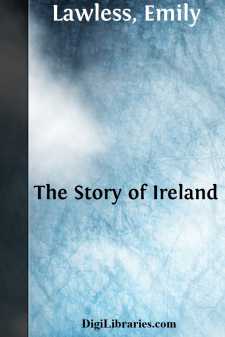Categories
- Antiques & Collectibles 13
- Architecture 36
- Art 48
- Bibles 22
- Biography & Autobiography 813
- Body, Mind & Spirit 141
- Business & Economics 28
- Children's Books 12
- Children's Fiction 9
- Computers 4
- Cooking 94
- Crafts & Hobbies 4
- Drama 346
- Education 46
- Family & Relationships 57
- Fiction 11826
- Games 19
- Gardening 17
- Health & Fitness 34
- History 1377
- House & Home 1
- Humor 147
- Juvenile Fiction 1873
- Juvenile Nonfiction 202
- Language Arts & Disciplines 88
- Law 16
- Literary Collections 686
- Literary Criticism 179
- Mathematics 13
- Medical 41
- Music 40
- Nature 179
- Non-Classifiable 1768
- Performing Arts 7
- Periodicals 1453
- Philosophy 64
- Photography 2
- Poetry 896
- Political Science 203
- Psychology 42
- Reference 154
- Religion 513
- Science 126
- Self-Help 83
- Social Science 81
- Sports & Recreation 34
- Study Aids 3
- Technology & Engineering 59
- Transportation 23
- Travel 463
- True Crime 29
The Story of Ireland
by: Emily Lawless
Description:
Excerpt
I.
PRIMEVAL IRELAND.
"It seems to be certain," says the Abbé McGeoghehan, "that Ireland continued uninhabited from the Creation to the Deluge." With this assurance to help us on our onward way I may venture to supplement it by saying that little is known about the first, or even about the second, third, and fourth succession of settlers in Ireland. At what precise period what is known as the Scoto-Celtic branch of the great Aryan stock broke away from its parent tree, by what route its migrants travelled, in what degree of consanguinity it stood to the equally Celtic race or races of Britain, what sort of people inhabited Ireland previous to the first Aryan invasion--all this is in the last degree uncertain, though that it was inhabited by some race or races outside the limits of that greatest of human groups seems from ethnological evidence to be perfectly clear.
When first it dawns upon us through that thick darkness which hangs about the birth of all countries--whatever their destiny--it was a densely wooded and scantily peopled island "lying a-loose," as old Campion, the Elizabethan historian, tells us, "upon the West Ocean," though his further assertion that "in shape it resembleth an egg, plain on the sides, and not reaching forth to the sea in nooks and elbows of Land as Brittaine doeth"--cannot be said to be quite geographically accurate--the last part of the description referring evidently to the east coast, the only one with which, like most of his countrymen, he was at that time familiar.
Geographically, then, and topographically it was no doubt in much the same state as the greater part of it remained up to the middle or end of the sixteenth century, a wild, tangled, roadless land, that is to say, shaggy with forests, abounding in streams, abounding, too, in lakes--far more, doubtless, than at present, drainage and other causes having greatly reduced their number--with rivers bearing the never-failing tribute of the skies to the sea, yet not so thoroughly as to hinder enormous districts from remaining in a swamped and saturated condition, given up to the bogs, which even at the present time are said to cover nearly one-sixth of its surface.
This superfluity of bogs seems always in earlier times to have been expeditiously set down by all historians and agriculturists as part of the general depravity of the Irish native, who had allowed his good lands,--doubtless for his own mischievous pleasure--to run to waste; bogs being then supposed to differ from other lands only so far as they were made "waste and barren by superfluous moisture." About the middle of last century it began to be perceived that this view of the matter was somewhat inadequate; the theory then prevailing being that bogs owed their origin not to water alone, but to the destruction of woods, whose remains are found imbedded in them--a view which held good for another fifty or sixty years, until it was in its turn effectually disposed of by the report of the Bogs Commission in 1810, when it was proved once for all that it was to the growth of sphagnums and other peat-producing mosses they were in the main due--a view which has never since been called in question....


